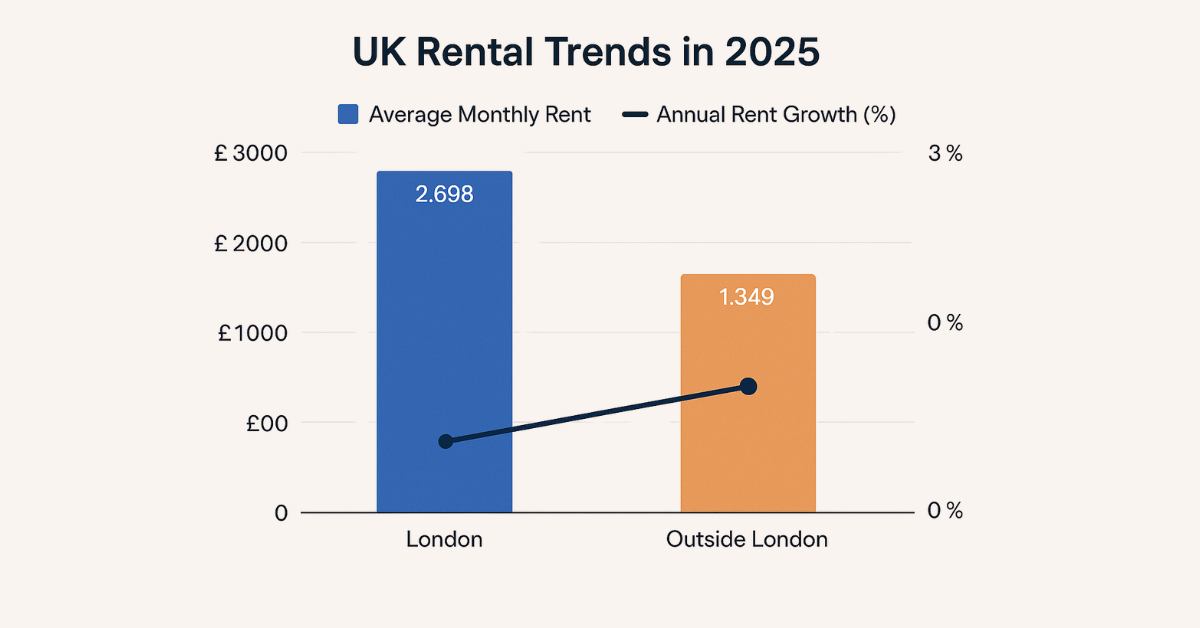As the UK rental market continues to evolve, staying informed about the latest trends is essential for landlords aiming to maximise their returns. According to Rightmove’s latest Rental Price Tracker, the rental landscape in 2025 is showing signs of change, with growth in average rents slowing and the supply of rental homes increasing. Here’s a detailed analysis tailored for UK landlords.
Instant Rental Price Estimator
Discover your property’s true rental value in seconds with our free, UK-wide price comparison tool.
- Key Rental Market Trends in 2025
- What These Trends Mean for Landlords
- Preparing for Regulatory Changes
- Tools to Help You Stay Ahead
- Frequently Asked Questions
Key UK Rental Market Trends in 2025
Average Rents Reach New Highs but Growth Slows
While average asking rents outside London hit a record £1,349 per month in early 2025, this represents only a 0.6% increase from the previous quarter—the smallest rise since 2020. In London, rents edged up by just £3 to £2,698 per month, another record high but a sign of cooling growth compared to previous years.
Improved Supply of Rental Homes
The number of available rental homes has grown significantly, with an 18% year-on-year increase. This improvement comes as new buy-to-let mortgage loans surged by 32% in early 2025, bringing more properties to the market.
Tenant Demand Eases Slightly
Tenant demand has dropped by 7% compared to March 2024, potentially due to an increase in first-time buyers. However, competition remains strong, with an average of 12 enquiries per rental property—down from 16 last year but still double the pre-pandemic average.
Regional Variations
Some regions are experiencing significant rental price increases. Chippenham in Wiltshire saw a 16.4% annual rise, followed by Stockport (16.1%) and Coventry (14.1%). Even traditionally lower-cost areas like Grimsby saw a 12% increase, reflecting a nationwide trend of rising rents.
What These Trends Mean for Landlords
Opportunities to Maximise Rental Returns
As rent increases slow, landlords have an opportunity to attract and retain reliable tenants by adjusting asking prices strategically. It’s also a good time to check if you’re paying excessive fees with your current letting agent. Paying less in fees and keeping more rent can significantly maximise your rental returns.
In addition, we’ve launched Vivo — our new end-to-end lettings platform. Over the past 15 years, we’ve gone from version 1 to version 5, purpose-built to support modern landlords with the tools and clarity you need to stay in control. LettingaProperty.com (powered by Vivo) now offers three new letting plans that are clearer and provide better value. Explore our plans & pricing page for more details.
For those wondering about their property’s potential, try our Instant Rental Valuation Tool to get an accurate estimate in seconds.
Managing Tenant Relationships
With more properties on the market and competition easing slightly, landlords have the opportunity to negotiate and secure long-term tenants. Understanding regional demand is key—London may see fewer enquiries per property, but areas like the North West remain highly competitive.
Navigating Affordability Challenges
Affordability is a growing concern, with rents having risen 40% since 2020 compared to a 31% increase in wages. As a landlord, offering flexibility in rental terms or considering modest price adjustments can make your property more appealing.
Preparing for Regulatory Changes
The upcoming Renters’ Rights Bill, expected later in 2025, may introduce new challenges, such as a ban on rent-in-advance payments. Staying informed about these changes will help landlords adapt and maintain compliance.
Tools to Help You Stay Ahead
- Compare Letting Agent Fees: Curious about letting agent fees in your area? Use our Fee Comparison Tool to see how much you could save.
- Expert Property Management Tips: Explore our blog for insights on effective property management strategies and ways to enhance your rental business.
Conclusion
The UK rental market in 2025 is characterised by a stabilising pace of rent increases, an improved supply of homes, and evolving tenant demands. By staying informed and leveraging tools like our Instant Rental Valuation and Fee Comparison services, landlords can navigate these changes effectively and maximise their returns.
—-
Frequently Asked Questions
1. How can I estimate the rental value of my property?
Use our Instant Rental Valuation Tool to get a quick and accurate estimate based on your property’s location and features.
2. What are the benefits of adjusting rent prices?
Adjusting rent strategically can help attract reliable tenants, reduce vacancy periods, and maintain competitive pricing in your area.
3. How does the Renters’ Rights Bill affect landlords?
The Renters’ Rights Bill introduces changes such as a ban on rent-in-advance payments. Staying informed and compliant will be key to managing these new regulations.
4. Why is tenant demand easing in 2025?
Tenant demand is easing due to factors such as an increase in first-time buyers and improved availability of rental properties compared to last year.
5. Which regions are currently the most competitive for renters?
Regions like the North West and parts of Scotland remain highly competitive, with more enquiries per rental property than areas like London.



